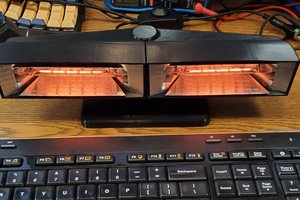As important as a biological microscope is, I believe that having a PCB inspection microscope to be more valuable in my personal lab setting. So working off the basics of the Pi scope I will attempt to create a functional inspection microscope.
Based on design work I completed on the biological IOT Pi Microscope found here: https://hackaday.io/project/11429-internet-of-things-microscope
Current Design Specs:
- Single 19.8 Watt adjustable LED Fiber Optic Light Source (if I was in marketing it's a solid 20 Watts) :)
- Dual 40cm Flexible Metal Gooseneck
- 5000K Lamp Color Temperature
- Forced Air Cooling System
- Produces 2741lm
Current issues to be solved:
- How much heat will the LED produce?
- Will a 3D printed ABS shell hold up to the extreme temperature?
- Is vibration isolation needed for the cooling fan?
- Can a Raspberry Pi fit in the case?
To do:
- Find a 5v DC-DC converter that can run off of the Meanwell 36volt LED power supply
- Buy core components
- Find a nice potentiometer to adjust the brightness of the LED
 Apollo Timbers
Apollo Timbers






 Juan-Antonio Søren E.P.
Juan-Antonio Søren E.P.
 Jan Mrázek
Jan Mrázek
 UCTRONICS
UCTRONICS
 compukidmike
compukidmike